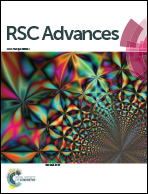Segmental dynamics, morphology and thermomechanical properties of electrospun poly(ε-caprolactone) nanofibers in the presence of an interacting filler†
Abstract
The effect of addition of an interacting nanofiller (Cloisite 10A) on the segmental dynamics, morphology and thermal stability of poly(ε-caprolactone) PCL is subjected to detailed investigation. Fibrous membranes of neat and nanocomposite PCL with varying amounts of Cloisite 10A were fabricated by electrospinning technique. The applied voltage and solution concentration were optimized and the effect of clay content of the nanocomposite materials on the final fibrous structure were investigated. Strong hydrogen bonding interaction between PCL and organic modifier of Cloisite 10A aids in the effective dispersion of the nanofillers, as evidenced by an increase in cooperatively rearranging regions. This is further correlated with a detailed wide angel X-ray scattering (WAXS) analysis along with transmission electron microscopy (TEM) studies. Sharp decrease in the hydrophobicity of PCL with addition of Cloisite 10A, shows that the fabricated nanocomposites can be a potential candidate for various biomedical applications. The cell viability studies also support this observation.


 Please wait while we load your content...
Please wait while we load your content...